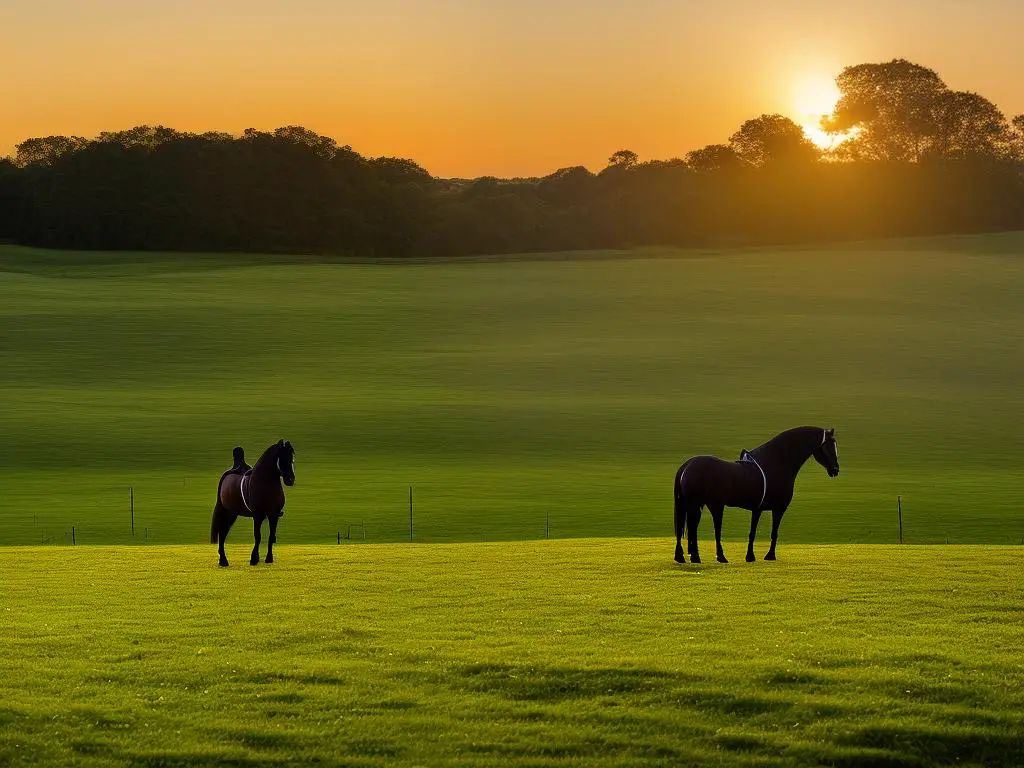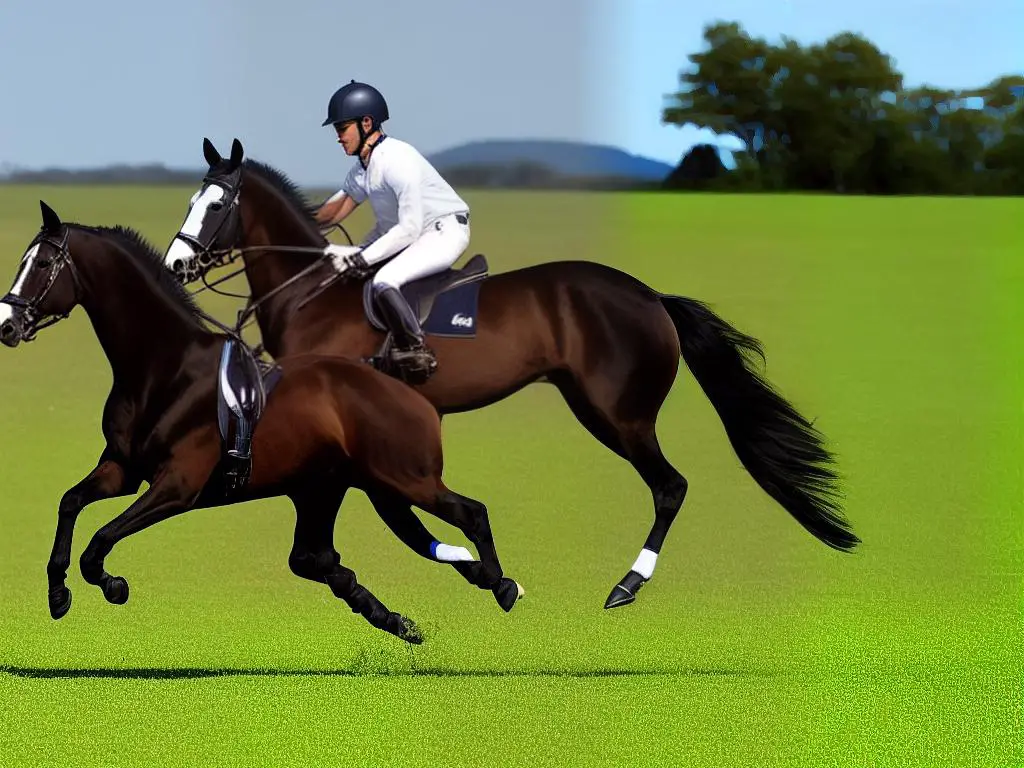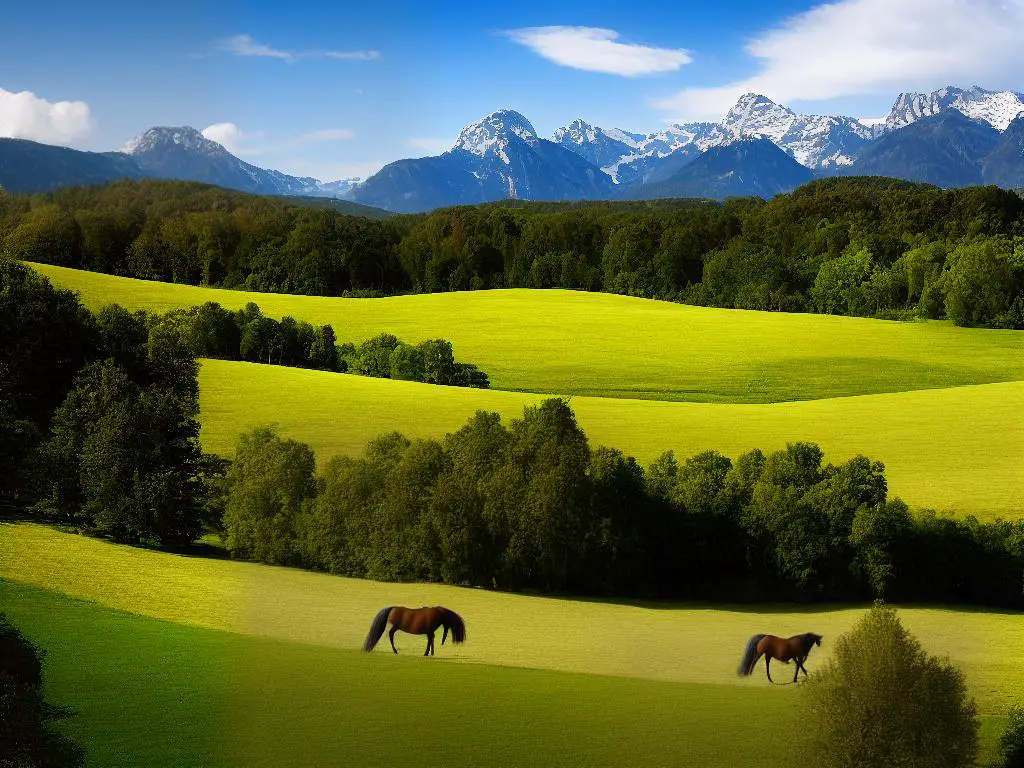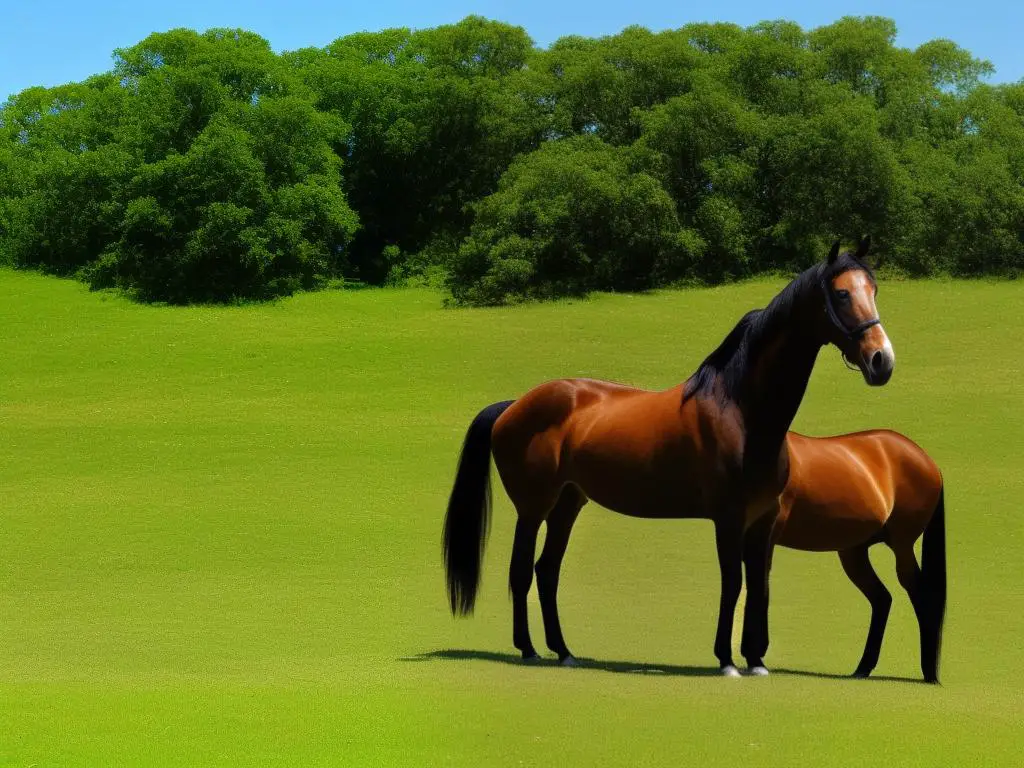French Saddle Horses, prized for their unique blend of resilience, agility, and aesthetics, hold a special place in equine history, particularly in the rich equestrian tapestry of France. These equine beauties, imbued with striking physical traits and renowned for their versatile performance across various equestrian sports, echo fascinating tales of their evolution and historical background. This exploration delves into the compelling past of these horses, their distinctive characteristics, their impactful role in equestrian sports, and the various aspects involved in their care and upkeep. An understanding of these facets provides a comprehensive picture of the irresistible allure of French Saddle Horses, making them one of the most cherished breeds among horse enthusiasts.
Table of Contents (Horspedia)
History of French Saddle Horses
Origins of French Saddle Horses
The French Saddle Horses, also known as Selle Français, originated in France in the 1950s. Developed as a sporting horse, the breed emerged from a sophisticated combination of native French horses and foreign breeds.
Native breeds such as the Anglo-Norman horse, a well-respected carriage and agricultural horse, and foreign breeds like the Thoroughbred, Arabian, and Norfolk Trotter were all part of the blend that eventually resulted in the French Saddle Horse. Each of these breeds contributed specific characteristics, serving to enhance the speed, strength, and muscle structure of the French Saddle Horse.
Development of the Breed
The development of French Saddle Horses was heavily regulated and fostered by the French Ministry of Agriculture. The ministry initiated breeding programs to further refine the breed, focusing more on its jumping and dressage capabilities. To this end, various studbooks were established to keep accurate records and ensure the preservation of the breed’s unique traits. Some notable studbooks regarding the breed are the French National Stud and the Stud-Book Selle Français.
In these breeding programs, Thoroughbred and Arabian stallions were often used to add speed, endurance, and agility to the French Saddle Horse. Over time, these efforts led to the modern French Saddle Horse – a horse celebrated for its athleticism, versatility, and exceptional performance in equestrian sports.
Historical Significance in French Culture
French saddle horses hold a significant place in French culture. Historically, these horses were critical to France’s agricultural economy, serving as work horses on farms. They were also used in various military campaigns, prized for their robustness and endurance.
In more contemporary times, French saddle horses have found fame in the sporting world. They have excelled in show jumping, dressage, and eventing competitions, regularly earning high rankings. The breed’s success in equestrian sports has bolstered France’s reputation in the international horse world, reinforcing its status as a leading producer of sport horses.
Major Impacts on the Breed’s Evolution
Key periods in history, such as World War II, have significantly affected the evolution of French saddle horses. The War led to a reduction in the demand for agricultural and working horses, prompting breeders to shift their focus towards producing sporting and riding horses.
Similarly, the advent of mechanization in the agriculture industry further necessitated this shift. With tractors and machinery taking over traditional horse labor, the role of horses in France underwent a major transformation. This led to a greater emphasis on refining the French Saddle Horse as a sport horse, giving rise to the elegant and athletic breed we know today.
Conclusion
To conclude, the French Saddle Horse embodies the time-honored traditions of the French horse breeding history. Its constant improvement over time underscores its importance to France’s cultural heritage. Known for its incredible versatility, athleticism, and exceptional performance in equestrian sports, this breed is celebrated globally.

Characteristics and Traits of French Saddle Horses
Origins and Characteristics of French Saddle Horses
French Saddle Horses, with their nobility and grace, originate from France’s lush pastures. They have gained worldwide recognition for their stamina, agility, and proficiency in competitive equestrian sports.
Also referred to as Selle Français, the origin of French Saddle Horses traces back to a mix of native French breeds combined with foreign breeds shaping the European horse breeding industry in the 19th century. In particular, they inherited their renowned speed and agility from Thoroughbreds and Anglo-Norman horses.
Physical Attributes of French Saddle Horses
On the physical side, French Saddle Horses display hefty and vigorous bodies. They usually stand tall between 15.1 to 17.3 hands (63 to 71 inches) at the withers, showcasing a broad and deep chest, along with a strong, sloping shoulder blade. Their head is well-set on a muscular, albeit slightly long, neck; the eyes are large, expressive, and the ears are alert. Their hindquarters are powerful, making them ideal for jumping events.
French Saddle Horses harbor a broad color spectrum, ranging from bay, chestnut to darker hues like black or brown. Some of them may have white markings on the face and lower legs, which adds an extra touch of allure to their appearance fit for a spectacle.
Gait Pattern and Behavior Traits
French Saddle Horses are known for their graceful and grounded gait. Their strides are remarkably straight and powerful, characterized by forceful hind legs that propel them forward in a springy fashion. This makes them an ideal breed for show jumping, eventing, and dressage competitions.
On the personality spectrum, French Saddle Horses exude a gentle nature despite their heavyweight stature. They are intelligent, eager to please, and exhibit considerable courage, a trait pivotal in enduring rigorous equestrian sports. Such attributes prompt respect and admiration among riders while also shaping a trusting, affectionate bond.
French Saddle Horse and Their Role in Equestrian Sports
Unsurprisingly, due to their size, strength, and agility, French Saddle Horses have been key players in international equestrian sports. Their stamina and resilience enable them to excel in long-distance endurance rides and high-energy activities.
Combine the physical prowess with an amiable temperament, and the French Saddle Horse becomes a preferred choice for amateur riders and jumpers, professionals alike. It is this precedence that led to their participation in various Olympics events, having won numerous medals over the years – a testament to their potency in the equestrian world.
Summing Up
Whether for their striking physical characteristics or their steadfast and charming personalities, French Saddle Horses are a breed that deserves applause. Their significant contribution to the world of horsemanship, alongside their enduring elegance, ensures they stand out as a truly unique equine breed.

French Saddle Horses’ role in Equestrian Sports
French Saddle Horses: Champions in the Equestrian Arenas
Known as the Selle Français in their native land, but generally referred to as French Saddle Horses, these equine athletes are celebrated for their versatility and athletic prowess. Having a proven track record in horse shows including those of showjumping, eventing and dressage, it attests to their abilities in a range of equestrian events.
Dynamic Role in Equestrian Sports
In Dressage, French Saddle Horses have displayed dexterity and agility, thanks to their powerful hindquarters and their natural tendancy for suspension. Notable French Saddle Horses in Dressage include names like Flipper d’Elle and Roxane de la Maze who have competed and won on the global platform.
Showjumping is another terrain where French Saddle horses dominate. Their speed, power and their natural instinct for jumping, paired with an excellent mentality, have paved their way to international horse championships. Horses like Quidam de Revel and Baloubet du Rouet have honorably represented the French saddle horse breed in this sport and made remarkable achievements.
In eventing, the stamina, courage, and versatility of the French Saddle horses come into play, making them the preferred breed. French Saddle Horses have repeatedly won individual and team medals in European, Olympic, and World Championships.
Prominent Riders and French Saddle Horses
Prominent individuals in the equestrian world have trusted their careers to French saddle horses. Ludger Beerbaum, a renowned German showjumping rider, achieved multiple Olympic wins partnering with the French Saddle Horse Ratina Z.
Another notable French saddle horse, Jappeloup de Luze, ridden by Pierre Durand, won the individual show jumping gold medal at the 1988 Seoul Olympics. This iconic pairing is still celebrated in the hearts of equestrians today, and their story has been immortalized in a French film titled “Jappeloup.”
Furthermore, Milton, a very successful French Saddle Horse, was ridden by John Whitaker. The pair enjoyed notable victories including multiple World Cup wins, illustrating the prowess of this breed at the highest level of competition.
Conclusion
To conclude, it is clear that French Saddle Horses, or Selle Français as they are known in France, have an indelible impact on equestrian sports due to their athletic capabilities and versatility. The consistent international accomplishments of these horses have led to their recognition by top riders worldwide, showcasing the breed’s exceptional attributes. It’s a testament to their inherent strengths, although the triumph of each horse greatly depends on professional training and a solid rider partnership.

Caring for a French Saddle Horse
Introduction to French Saddle Horses
Known for their adaptability and athletic prowess, the French Saddle Horses, commonly referred to as Selle Francais, are greatly cherished. These horses, originating from France, are predominantly used for jumping events. Still, they have proven their worth in an array of equestrian activities, including dressage, eventing, and show riding. However, if you’re considering making one a part of your life, you should be prepared to commit an ample amount of time, energy, and resources, as their care and maintenance can be quite demanding.
Feeding a French Saddle Horse
Quality nutrition is crucial for French Saddle Horses. These animals require a diet rich in quality hay or pasture, grains and special feed according to their activity level, age, and overall health condition. Owners should provide fresh and clean water daily and observe the horse’s eating habits closely. Any abrupt changes in appetite or eating patterns could signify health issues.
Grooming Regime
Regular grooming promotes the health and comfort of a French Saddle Horse by keeping the skin, coat, hooves, mane, and tail healthy. Common tasks include brushing, combing, hoof cleaning, detangling, and using fly repellents. Owners should also regularly inspect the horse for injuries or health issues such as skin infections. Equine dental check-ups and sheath cleaning are also vital, though usually carried out by a professional.
Training a French Saddle Horse
French Saddle Horses are famous for their aptitudes in jumping but require consistent training to maintain their abilities and overall fitness. Regular exercise helps to build strength and stamina while also encouraging mental stimulation. However, owners should be aware of not overworking their horse as this could lead to fatigue, illness, or injuries.
In-Depth Health Management
Regular veterinary check-ups are vital to manage the health of a French Saddle Horse. Common horse health issues include colic, lameness, respiratory problems, parasites, and hoof disorders. Equine vaccinations, deworming, and other preventative care are also essential to keep the horse fit. In addition, dental care for horses should not be overlooked.
Safe Sheltering
French Saddle Horses should have access to a suitable shelter that protects them from extreme weather conditions and hazards. The shelter should be regularly cleaned to prevent the spread of diseases and parasites. Additionally, it should be spacious enough to allow the horse to move around comfortably.
Recap: Owning a French Saddle Horse
Owning a French Saddle Horse is a big responsibility. Owners need to provide quality nutrition, make time for regular grooming, ensure consistent and suitable training, maintain comprehensive health management, and provide a safe and clean shelter for their horse. With proper care and attention, French Saddle Horses can live long, healthy, and active lives.

Undeniably, French Saddle Horses are a symbol of equestrian excellence, embodying an enchanting fusion of strength, agility, and elegance. Their rich heritage intertwined with the cultural fabric of France and their remarkable contribution to equestrian sports make them an extraordinary breed. Moreover, their distinct traits and characteristics, complemented by a resilient and engaging temperament, accentuate their appeal. The stewardship of these magnificent creatures, though requiring considerable effort and understanding, brings an unmatched sense of fulfillment to those fortunate enough to experience it. May this exploration into the world of French Saddle Horses serve as both an informative guide and an ode to these spectacular equine marvels.
